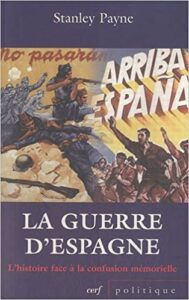
The Spanish Civil War still excites strong passions. This encyclopedic collection of Stanley Payne’s essays on the subject, published in French in 2010, is a must-read for anyone wishing to understand that controversial event. The author is perhaps the world’s premier scholar on the war, and the essays in this work of over 600 pages abound in information about the leading participants in that struggle, the war plans implemented by the Nationalists and Republicans, the costs and casualties sustained by each, and the contending interpretations of the conflict.
The war lasted from July 16, 1936, until April 1, 1939. By the time the bloodbath ended, it claimed the lives of about 150,000 combatants; almost as many civilian Spaniards, including luminaries in the conservative opposition, were killed by death squads during the conflict. The Nationalists ended up executing even more enemies, some in the postwar period. But that was only because they won the struggle. Payne has no doubt that if the leftists had prevailed, they would have wiped out at least as many unwanted people.
Because of his support for the prolific Spanish historian Pìo Moa and other scholars who have challenged the now-official Spanish narrative about the noble democratic left battling the “fascists,” Payne has been decried by the Spanish left as an apologist for the Nationalists. Nothing could be further from the truth, as he is a meticulous researcher who specializes in carefully balanced judgments. Reading Payne’s biography of Francisco Franco, for example, leaves readers more critical of his subject, not less. Payne spares no detail in describing the revenge that the Caudillo took on his captured enemies after his victory and the opportunistic way in which he dealt with Nazi Germany, before the war turned against the Axis powers, in order to gain control of Gibraltar and French Morocco.
What makes Payne entirely credible, besides his vast knowledge of the subject, is his well-argued position that the outcome of the war may have been the least destructive possible, given the grim circumstances. Neither side in a polarized interwar Spain favored a liberal parliamentary regime—with the exception, Payne writes, of the Radical Republicans. (Unlike Payne, Pìo Moa would include the Catholic conservative CEDA party among those committed to the Republican constitution.)
The Spanish left, as Payne cogently demonstrates, was pursuing a totalitarian agenda from at least October 1934 on; it had shown its hand even earlier, during the establishment of the Spanish Republic in 1931, when it acquiesced in or participated in violence against the Catholic Church.
The international brigades that began arriving in Spain in July 1936 were made up overwhelmingly of Communists and Communist sympathizers. The Soviet Comintern organized these “volunteers” with help from the French Communist Party. Although those who led the brigades claimed to be fighting “fascism,” they faithfully served Stalin’s interests, and it wasn’t long before Soviet agents took a commanding position in running the Republican armed forces and proceeded to wipe out their rivals on the left. Although German aerial forces and 80,000 Italian fascist troops with accompanying arms were made available to the Nationalists, no foreign power controlled the Nationalist side in the same way as the Soviets dominated the Republican one.
Unlike George Orwell and others, who blamed the Communists for the failure of the Republicans to crush the uprising on the right, Payne considers the Communists to have been only a secondary problem for those fighting against the Nationalists. He argues that the Republicans’ main problems were glaring deficiencies in planning and executing strategy, infighting, and the appalling eruptions of leftist violence. Spanish anarchists and non-Soviet-allied socialist revolutionaries committed countless atrocities, often against Catholic clergy. It was also exceedingly hard to combine these fractious elements of the left into a disciplined, coordinated fighting force. The Nationalist side was far better commanded and ran the territory it occupied more efficiently and with less disruption. It managed to win despite enormous initial disadvantages in manpower, armaments, and funds for purchasing weapons abroad.
By the time the Nationalist uprising came to pass, those who backed it had every reason to revolt against a Republican regime that refused or was unable to stop the killing and looting committed by its followers. One of the incentives for recalling these atrocities and illegalities of the Spanish left during Spain’s national trauma is what has happened with revisionist scholarship and public commemorations in recent decades. Starting in 2007, Spain’s socialist government has worked overtime to glorify counterfactually the Republican commitment to freedom and democracy. Surviving members of the International Brigades were granted Spanish citizenship as early as January 1996, and what survived of a post-Franco conservative opposition voted mostly with the left. Under socialist rule, the government took another ideological step by subsidizing pro-Republican polemics and exaggerated accounts of Nationalist atrocities.
Payne’s book restores scholarly standards to a field that remains more than ever beset by ideological controversy.
(Paul Gottfried)
Leave a Reply